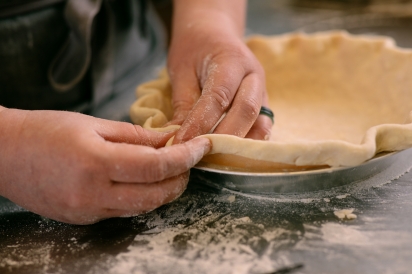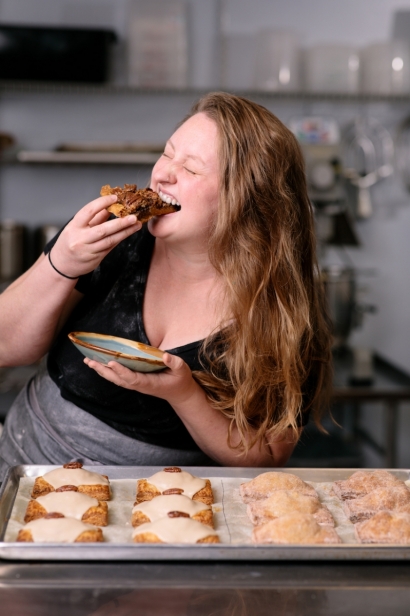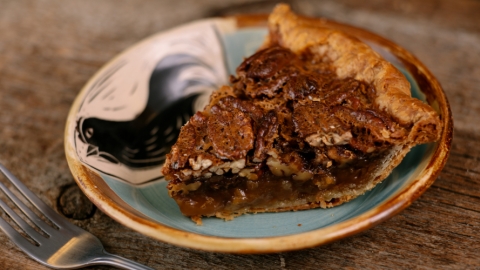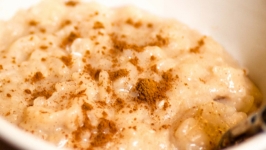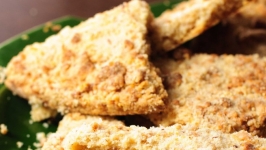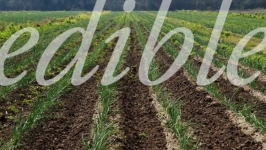Holiday Pie Guide
Baking a holiday pie can be intimidating. Luckily, we at Edible Milwaukee are here to help you answer all of your questions with our Holiday Pie Guide! We collaborated with Allison Cebulla, owner of Hatched, to provide you with guidance through the tribulations of baking so you can be sure to impress your guests this holiday.
Every great pie starts with a plan. You can’t go wrong with a pumpkin, pecan or sweet potato pie in the winter months, but other options exist. Custard pies are historically classified as winter pies because of the lack of fresh fruit available. This doesn’t mean you can’t make a fruit pie, however. Just be warned that you should use fruits that are in season, like citrus fruits, apples or cranberries. Fruits out of season like strawberries or blueberries won’t taste as bright in the winter.
The crust can make any average pie a masterpiece. Crusts can be made in advance, saving time at the arms-race of preparing dinner, but it is also the most finicky element of a pie. Be sure not to overmix your pie dough. The dough should just come together, showing bits of fat and flour that haven’t been fully incorporated. Those leftover bits give your crust a flaky texture. Pie dough has to be kept chilled, so try not to use your hands to mix. A food processor is best for mixing because it keeps things very cold, and can easily break down your fat into manageable pieces if frozen or refrigerated.
There are options when choosing which fat to utilize: lard, butter or shortening. A crust with lard will give you a delicate and flaky crust as well as a good rise. Butter will provide a great flavor, while shortening gives you a sturdier dough, good for intricate designs. Feel free to mix your fats in whichever ratio you like best. After you have done the preliminary crust mixture, resting the dough in the fridge is paramount.
When mixing a filling, you need to be aware of the binding agent. Custard and squash pies naturally firm up in the oven and don’t generally need added help. Fruit pies, on the other hand, have a sticky syrup that holds the filling together, but getting the right consistency of that “goo” is hard to achieve. Fruits release pectin as they break down, which acts as a thickener. Some fruits, like apples and pears, have more pectin and don’t require very much thickener added to the filling. Other fruits, like berries, release less pectin and need an added boost to avoid a filling that runs out when slicing. When adding a thickener, opt for tapioca starch. It leaves a silky consistency without any cloudiness, like you’d get from using corn starch.
When it comes to assembly, lay the bottom pie crust on a glass baking dish, so you can clearly see the color and flake as opposed to using aluminum. Prick the base of the crust with a fork to prevent any air bubbles from forming under the crust. If you are making a custard or squash pie, you’ll have to blind bake your crust. Custards require a low and slow cooling method, which can leave the crust undercooked when the filling is done.
You can decorate your pie in any way you’d like, be it a crumble, full crust or even a lattice, but if you are making a custard pie, do not cover your pie! Custards and squash have a very high moisture content, and that moisture needs to evaporate in your oven. If that liquid doesn’t evaporate, you’ll be left with a soupy mess.
The crust of a good pie should be a golden-brown color, comparative to brown sugar. When baking a fruit pie, the filling should be thick and bubbling in the middle of the pie. For a custard pie, the outer perimeter of the custard should be firm and risen, and the inner two inches of the filling should jiggle when you shake it. That slight jiggle in the middle of the pie will cook through as the pie rests on the counter, assuring that there will be no cracking of the surface; a typical sign of an overbaked pie. Once your pie is out of the oven, let it rest in the pie pan until thoroughly cooled.
The only way to achieve a consistently good pie is to practice. However, it is always wise to have a backup in case of disaster (or unexpected guests). Should that be the case, I recommend picking up a stellar holiday pie from Hatched. You can reach Allison at (414)418-5217 with any questions about holiday pickup information or orders or send a message to her inbox at hatchedmke@gmail.com.



